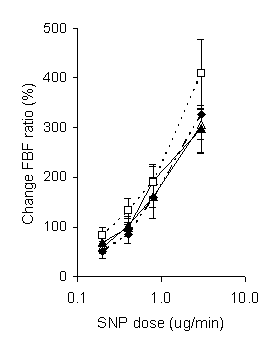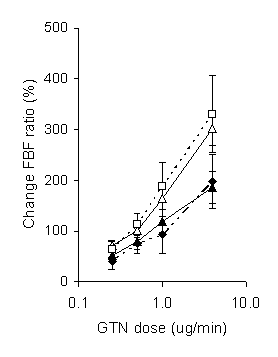| pA2 online © Copyright 2004 The British Pharmacological Society |
148P
University of Newcastle Winter Meeting December 2004 |
Aldehyde dehydrogenase 2 and the bioactivation of glyceryl trinitrate in humans
Isla S. Mackenzie, Kaisa Maki-Petaya, Carmel M. Mceniery, Yi Ping Bao, Sharon Wallace, Joseph Cheriyan, Sue Monteith, Morris J. Brown |
|
The mechanism underlying the bioactivation of nitrates is not fully understood but recent animal data suggest that mitochondrial aldehyde dehydrogenase (ALDH2) may play a central role [1, 2].
We investigated the consequences of pharmacological or genetic reduction in ALDH2 activity on the vascular effects of nitrates in humans in a series of studies. Forearm blood flow (FBF) responses to intra-arterial infusions of GTN (0.25, 0.5, 1 and 4 µg min-1) and two control vasodilators, sodium nitroprusside (SNP) (0.2, 0.4, 0.8 and 3 µg min-1) and verapamil (10 and 30 µg min-1), in 12 healthy Caucasian volunteers, were measured before and after ALDH2 inhibition by disulfiram (600mg daily for 2 days). In a second study, five East Asian subjects, heterozygous for the glu504lys loss of function ALDH2 mutation [3], and four homozygous wild-type control East Asian subjects received intra-arterial infusions of GTN, SNP and verapamil, as above, on a single visit, and forearm blood flow responses were measured. Thirdly, we confirmed that ALDH2 was expressed in six different human internal mammary artery specimens, using reverse transcriptase-PCR of cDNA, confirming PCR product identity by sequencing and restriction enzyme digestion at an internal Mbo1 site.
GTN, SNP and verapamil each caused a dose-dependent vasodilatation. However, only the response to GTN ( p = 0.001; anova) was significantly reduced following disulfiram therapy. In the East Asian, the vasodilatory response to GTN ( p = 0.011; anova), but not SNP or verapamil, was less in the heterozygotes for the glu504lys mutation than in the wild-type control subjects (Figure 1).
In summary, we have shown that both pharmacological and genetic inhibition of ALDH2 reduce vasodilatory responses to GTN, and that ALDH2 is expressed in human arteries. Together, these findings suggest that ALDH2 is involved in the bioactivation of GTN in humans in vivo. This may be of clinical importance in patients with mutations in the ALDH2 gene and may also have implications for patients taking drugs that inhibit ALDH2 who require nitrate therapy.
Figure 1


FBF responses to SNP and GTN before (∆) and after (▲) disulfiram, and in East Asian ALDH2 heterozygotes (![]() ) and wild-type controls (
) and wild-type controls (![]() )
)
1. Chen Z, et al . PNAS 2002; 99: 8306.
2. Zhang J, et al .Circulation 2004; 110: 750.
3. Oota H, et al .Ann Hum Genet 2004; 68: 93.
This work was supported by the British Heart Foundation and a Sackler Award.